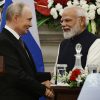
Nasa rover Perseverance will arrive into the planet’s orbit on February 18
Astronomers call it the “seven minutes of terror”: the chilling window in which a spacecraft has to fly 100km through Mars’s atmosphere and down towards its red, raggedy surface. At temperatures of 1,000°C, and facing notoriously unpredictable winds, the machine has to slow its speed from 12,000mph to about 2mph.
Much of the work is done by an air-resistant heat shield, which drags its speed down; then, it deploys a supersonic parachute.
Usually, with just a few miles to go, the probe breaks off from the spacecraft’s backshell; it is then guided to the surface by miniature rockets, which must immediately sever themselves once the probe hits the ground, so it is not dragged away into a crater. If all has gone right, the probe is then left alone, silent in an almost entirely unexplored world upon which humans have only ever dreamed of stepping foot.
It is this perilous journey that two competing probes – built by the US and China – will soon make. For NASA, the day of reckoning arrives as soon as Thursday, February 18, when its rover, Perseverance (a 10-ft long vehicle with six wheels, about the size and weight of a Mini), will arrive into the planet’s orbit and immediately descend to the surface.
China’s rival Tianwen-1 spacecraft arrived into Mars’s orbit on Wednesday; it will spend three months mapping the planet from afar, before descending to the surface in May.
China’s arrival came just one day after the Hope probe, built by the United Arab Emirates (a first for the Arab world), went into Mars’s orbit; unlike the others, it will not descend to the surface. All three were launched last July, when Earth and Mars were at their closest point in their journey around the sun.
USA Nasa Perseverance
It is a moment of almost incomparable excitement for astronomers, who expect these three unmanned missions to teach us more about our nearest planet than ever before; including, possibly, the long-mulled question of whether it has ever supported life.
But the prospect of rival probes from the world’s two greatest powers touching down within months of each other also encapsulates what Nasa historian Rod Pyle calls the “Space Race 2.0”: a new era of geopolitical competition in interplanetary travel.
“We’re all in it to explore, to understand our place in the universe better,” says Professor Andrew Coates, deputy director of the Mullard Space Science Laboratory at University College London, and principal investigator for one of the cameras on the American probe (his job is to map the planet’s mysterious geology). “I think that’s what’s driving all of these missions – but of course there’s an element of nationalism.”
If the first Space Race was driven by Cold War competition, the second can be explained largely by the rising economic power of Asia. Since 2003, when its Communist government sent its first person into space (Yang Liwei, a former pilot for the People’s Liberation Army), China has executed three successful lunar landings — including that of Chang’e-4 in 2019, which became the first probe to land on the far side of the Moon. India, too, has ambitions, having launched 109 space missions since 2008.
China: Tianwen-1
Also responsible is the dramatic fall in the cost of space travel over the last decade or so, which allows rising economies to get “more payload into space for fewer dollars”, according to Leonard David, author of Mars: Our Future on the Red Planet. Indeed, star-searching has become so accessible that now private billionaires like Jeff Bezos and Elon Musk are jockeying for action.
If the aim of the first Space Race was landing a human on the Moon, the glittering trophy of the second is eventually to land a person on Mars.
Named after the Roman god of war, the mysterious Red Planet has fascinated humans ever since it was spotted through a telescope by Galileo Galilei in 1610. The sight in the 19th century of what appeared to be intelligently-designed “canals” on its surface sparked a generation of fiction, from HG Wells to CS Lewis, most of which imagined Martians as a race of monstrous green stick figures.
Those notions were dispelled in 1965, when an American probe became the first to transmit close-up photographs of the planet. But, if anything, those images of Mars’s ragged and almost beautifully desolate surface – cratered, with enormous canyons, volcanoes, and dry lake beds – only added to its allure.
Much can go wrong; about half of the machines launched towards Mars since 1964 have crashed. Few understand this better than Dr Colin Wilson, an Oxford University physicist who remembers sitting in his in-laws’ house on Christmas Day 2003, eating dinner with one eye on the TV, as the British-built Beagle 2 probe – for which he built a wind-measuring instrument – lost contact with Earth.
Then, in 2016, he sat in the control room of the European space operations centre and watched it happen all over again, this time for Europe’s Schiaparelli spacecraft.
“We were watching a screen which showed a spike corresponding to the radio signal,” he remembers. “The parachute was cut away much sooner than expected – that was the first signal that something was wrong. The probe thought it was on the surface when it was still 4km up… it then fell the last 4km. The spike we were watching on screen just disappeared. Everyone [had to] rummage around and find a Plan B.”
But, if successful, the scientific prizes could be phenomenal. The main goal of America’s probe is to find the golden nugget that has eluded astronomers for centuries: proof of life.
It will drill about 6cm into the rocky surface; some rocks will be analysed on board for evidence of historic life, and some will be cached for a return to Earth at the end of this decade. It will also measure wind and dust, and will become the first probe to launch a helicopter from the planet’s surface – all of which is useful for our understanding of whether Mars’s climate might ever have been conducive to life, as well as our understanding of climatology here on Earth.
Perseverance will also try to make oxygen from the air, taking us a step towards eventually launching a rocket from the Martian surface – necessary for when, one day, we try to transport humans there and back in one piece.
China is more secretive about the aims of its own probe, but we know that Tianwen-1 will look for signs of ice in the Utopia Planitia basin, which future human colonists could use as water.
But even the most starry-eyed scientists accept there is a geopolitical element, too. “China is on a long march to establish itself as a vibrant spacefaring nation,” says David. “They will soon begin building their own space station in Earth’s orbit [and] they are pressing forward on an agenda of lunar exploration – one that will eventually lead to China placing home-grown boots on the Moon.”
Some Western analysts believe China’s ultimate aim is to set up a lunar base to exploit the moon for its rich resources.
And the US military has become increasingly concerned about China’s closely-guarded ambitions. Lloyd Austin, President Biden’s new Defence Secretary, called last month for America to adopt a “laserlike focus” on maintaining its military edge over China, including the possibility of building “space-based platforms”.
It came two years after Donald Trump launched the US military Space Force.
“We are seeing the high ground of military strategy move from ocean, land and air-fighting capability into space – and even out to the Moon,” says David.
But astronomers are keen to dispel the idea that we are entering a new Star Wars. Coates points out there was a great deal of scientific co-operation between the American, Chinese and UAE teams involved in this week’s missions, through the Mars Exploration Programme Advisory Group. “[It’s there to] make sure we’re looking at slightly different, complementary things,” he says.
UAE: Hope orbiter
“To have missions launching to Mars during a pandemic – I think there’s something really inspirational about that. We’re going to try and answer bigger questions for humanity.”
During a period of such difficulty on our own planet, he thinks, we should be grateful for something that urges us to look up to the stars.























































Свежие комментарии